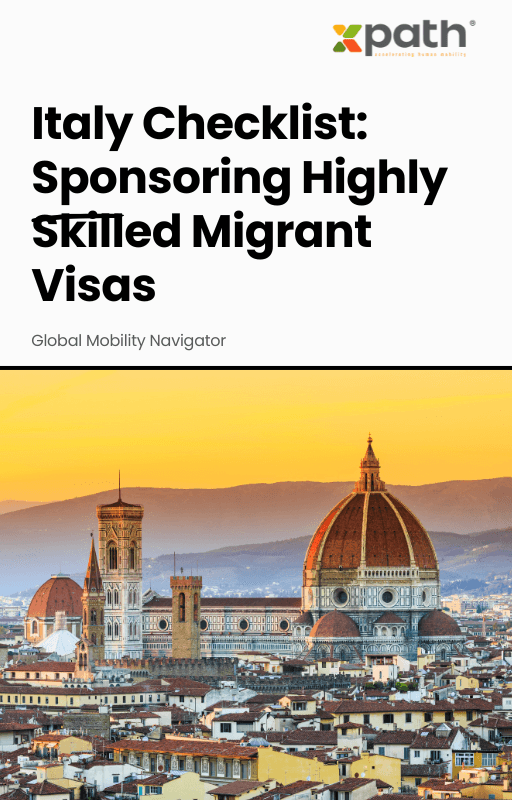Italy Checklist: Sponsoring Highly Skilled Migrant Visas
Grab a copy of a guide to international employee relocation
View E-bookOn June 9, 2025, a sweeping travel ban affecting nationals from 19 countries took effect, marking a significant shift in U.S. immigration policy under President Donald Trump’s second term. The proclamation, signed on June 4, imposes full or partial restrictions on entry for citizens of these nations, citing national security concerns and inadequate vetting protocols. Below is a comprehensive breakdown of the ban’s scope, exemptions, and unresolved questions.
The ban categorizes countries into two groups:
Full Suspension (12 countries):
Nationals of Afghanistan, Burma, Chad, Republic of the Congo, Equatorial Guinea, Eritrea, Haiti, Iran, Libya, Somalia, Sudan, and Yemen are barred from entering the U.S. as immigrants or nonimmigrants (e.g., tourists, students, workers).
Partial Restrictions (7 countries):
Nationals of Burundi, Cuba, Laos, Sierra Leone, Togo, Turkmenistan, and Venezuela face bans on immigrant visas and nonimmigrant B (business/tourism), F (student), M (vocational), and J (exchange visitor) visas. Other nonimmigrant visas (e.g., H-1B, L-1) may still be issued but with reduced validity periods.
The ban applies only to individuals who:
🔸Were outside the U.S. on June 9, 2025, and
🔸Did not hold a valid visa as of that date.
Exemptions include:
🔸Lawful permanent residents (green card holders).
🔸Dual nationals traveling on a passport from a non-banned country.
🔸Existing visa holders (visas issued before June 9 are not revoked).
🔸Diplomats (A/G/NATO visas), athletes (e.g., World Cup, Olympics), and certain family-based immigrants (with DNA evidence for relationships).
🔸Asylees, refugees, and individuals granted protection under the Convention Against Torture (CAT).
National Interest Exceptions (NIEs):
The proclamation allows case-by-case waivers for travelers deemed to advance U.S. national interests (e.g., critical infrastructure workers, investors). However, the criteria and application process remain unclear, leaving businesses and universities in limbo.
Visa Validity for Partially Restricted Countries:
While consulates may issue non-suspended visas (e.g., H-1B for Venezuelan nationals), the proclamation mandates shorter validity periods. The specifics of these reductions are undefined, potentially disrupting long-term employment or study plans.
Ambiguity for Current U.S. Visa Holders:
The State Department confirmed that existing visas remain valid, but it’s unclear whether:
🔸Current visa holders can renew or change status after June 9.
🔸Individuals physically in the U.S. on June 9 can re-enter if they travel abroad later.
Legal and Humanitarian Concerns:
Critics argue the ban disproportionately targets African and Muslim-majority nations, echoing controversies from Trump’s first term. Advocacy groups highlight exemptions for Afghan allies (SIVs) but condemn restrictions on refugees fleeing violence in Haiti and Yemen.
🔸Business and Academia: Companies with employees from affected countries face hiring hurdles, while universities anticipate declines in international students (particularly F/J visa holders from Venezuela or Iran).
🔸Reciprocal Measures: Chad has already announced reciprocal restrictions on U.S. citizens, and other nations may follow.
🔸Periodic Reviews: The ban is not permanent; the State Department must reassess restrictions every 180 days, potentially adding or removing countries (e.g., Egypt is under review).
The June 2025 travel ban reflects the Trump administration’s renewed focus on immigration enforcement and national security. While the policy’s legal foundation—rooted in the Supreme Court’s 2018 Trump v. Hawaii ruling—may shield it from immediate challenges, its implementation leaves critical gaps. Stakeholders await further guidance on NIEs and visa processing, but for now, the ban signals a restrictive era for global mobility to the U.S.
For ongoing updates, refer to the Department of State or consult immigration legal counsel.
Ready to transform your mobility program? Explore xpath.global’s solutions.
Previous article

Italy Checklist: Sponsoring Highly Skilled Migrant Visas
Grab a copy of a guide to international employee relocation
View E-book